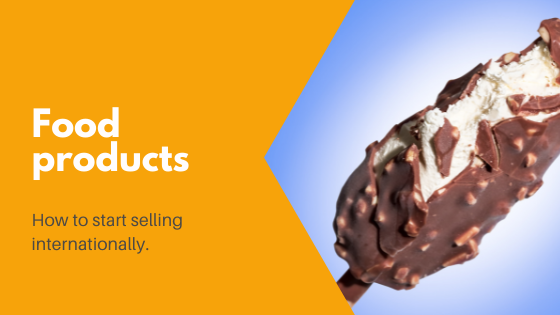A checklist of what to prepare, so you can grow your food business beyond your country’s borders.

Want to grow your food business?
Whether you process foods or manufacture them, one way to grow your food business is by accepting international orders and exporting your products to other countries.
But is it as simple as choosing a destination country for your products and then off you go?
Not really. There’s actually quite a bit of legwork involved before you go from a local following (and domestic sales) to foreign markets (and international sales).
Some food products need no introduction; others need you to invest in building awareness and interest for what you’re selling. Some products can be sold direct to consumer; others need middle-men to land your products in front of more shoppers. And certain food items are easier to send internationally than others.
All this to say there’s a lot to figure out—and do!—before you can start serving foreign customers.

What you need to start selling food products internationally
1. Do your research
If there are no customers, then there is no business.
That means you can’t just pick a country and start selling your products there. Among others, there are language barriers to overcome, payment channels to figure out, regulations to follow and shipping to get in order.
If you want to grow your food business, your very first step should always be to do your research—that’s how you avoid costly mistakes.
You’ll look into things like:
- Is there demand for your product?
- How large is the potential market?
- Who are your customers?
- How much of that market can you realistically capture?
- How competitive is the market and who are your main competitors?
- What are the price points for your type of products?
- Are there preferred routes to market and ways of purchasing these products?
- What are the import duties?
- What are the import regulations and requirements?
- Are you compliant with food hygiene and safety requirements?
- How will exchange rates impact business?
- How about the supply chain and logistics?
2. Pick the right products
Tastes, preferences and even food trends differ from country to country.
So while it might be tempting to ship off all your local best sellers, keep in mind that not every one of your cherished products will have a market overseas.
In short, be selective about what you choose to export. Pick those that have the greatest appeal or items that your research shows people are actually interested in—these have the highest likelihood of success in the destination country.
3. Find the best way to reach buyers
How are you going to find, reach and then serve international customers?
For example:
- Can you set up an online store on your website and partner with a courier service for shipping?
- Should you sell your products on Amazon?
- Do you need to find import and export partners to get your products in foreign supermarkets?
Whatever you choose to do, you’re going to need GREAT sales copy: delicious web copy, product descriptions and effective brochures.
How to find import and export partners
- Attend relevant expos – they are the perfect opportunity to network!
- Visit government websites such as those for the department of trade or customs. You might be able to find a list of registered importers.
- Go through the yellow pages and online listings for relevant companies you can contact.
- Take a look at classified / wanted ads that can be found in newspapers or on trade websites.
- Do your research the analog way. Whether you’re traveling overseas or simply shopping at your local supermarket, imported products are labelled with the importer’s name and address. Contact them for more information.
Tip: Make it easy for potential partners to find you with web copy that is optimized for search engines.

4. Update your website
Your website isn’t just a source of important brand and product information—it’s also how people learn you exist.
That’s why your website isn’t a set-and-forget project.
It’s a continuous work in progress that needs to be updated and improved.
For example: When you first launched, your website was probably optimized for your home market. It was designed to appeal to locals and written for domestic target segments in your native language. For example: it’s all in Thai.
But if you’re trying to grow your food business and sell internationally, your website must – at the very least – be useful to foreign customers. Consider this: A German-speaking prospect won’t get very far on a Thai website — but he’ll manage with English text.
That means it makes sense to have a high-quality English version—it’s the lingua franca of the business world and the most cost-effective way to reach new customers.
Should your website be translated into multiple languages?
If you can afford to localize and / or translate for every new market then why not? But for small food businesses, that’s not always a practical option. It’s expensive to do and, unless you have a dedicated team, difficult to maintain. You need staff fluent in that language. A more affordable option is to create an English-language version of your website and let a copywriter help when needed.
5. Attend relevant trade fairs
If your budget permits, attend relevant trade fairs. Trade fairs can be a great way for you to promote your product(s) as well as meet potential partners and interact with local buyers—all things you need to grow your food business!

6. Get your packaging export-ready
While it’s important for your packaging to be eye-catching, getting your product ready for export means a lot more than simply having a stunning, stand-out design.
You also need to make sure your packaging meets regulatory requirements in the country you’re exporting to.
For example:
- In some markets, materials that come into contact with food (“food contact materials and articles”) are regulated. That includes the materials used in food packaging.
- Make sure you follow destination-country food labeling guidelines. This includes proper ingredients lists, mandatory allergen information, nutrition information, country of origin for certain products, etc.
- There may also be language considerations. For example: products bound for Canada are required to have bilingual labeling.
Once your packaging is compliant, you have to turn your attention to the packaging’s marketability.
Foreign text can add to a product’s exotic appeal (and novelty factor) but there are also practical considerations like helping shoppers immediately understand what your product is—and how to enjoy it!
For example: if it comes with preparation instructions, a graphical how-to may not always be enough. Adding English text could make a big difference.
Tip: Attention-grabbing packaging is important but when the product is in a shopper’s hands, it’s the text that will convince him to give your product a try—and add to cart.
7. To grow your food business, you might need to customize your products
Can you increase sales by customizing your product for its new market? It’s worth investigating.
For example:
- In some countries, consumers prefer jumbo or bulk sizes. In other areas, there are more single households where solo packs sell better.
- Some countries regulate the types of coloring or additives used in food products. Do your ingredients meet those requirements?
- Taste preferences also vary. Your ‘regular spicy’ might be considered ‘super spicy’ and not palatable to the majority of consumers. Will it be better to create a milder version, too?
Sometimes, you won’t have to make any changes at all. Other times, small adjustments make your products more attractive abroad.